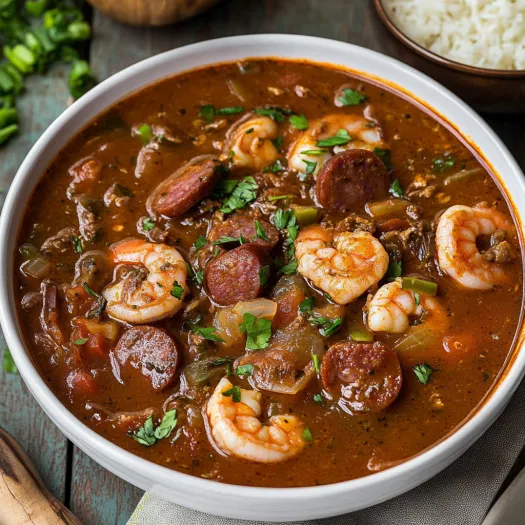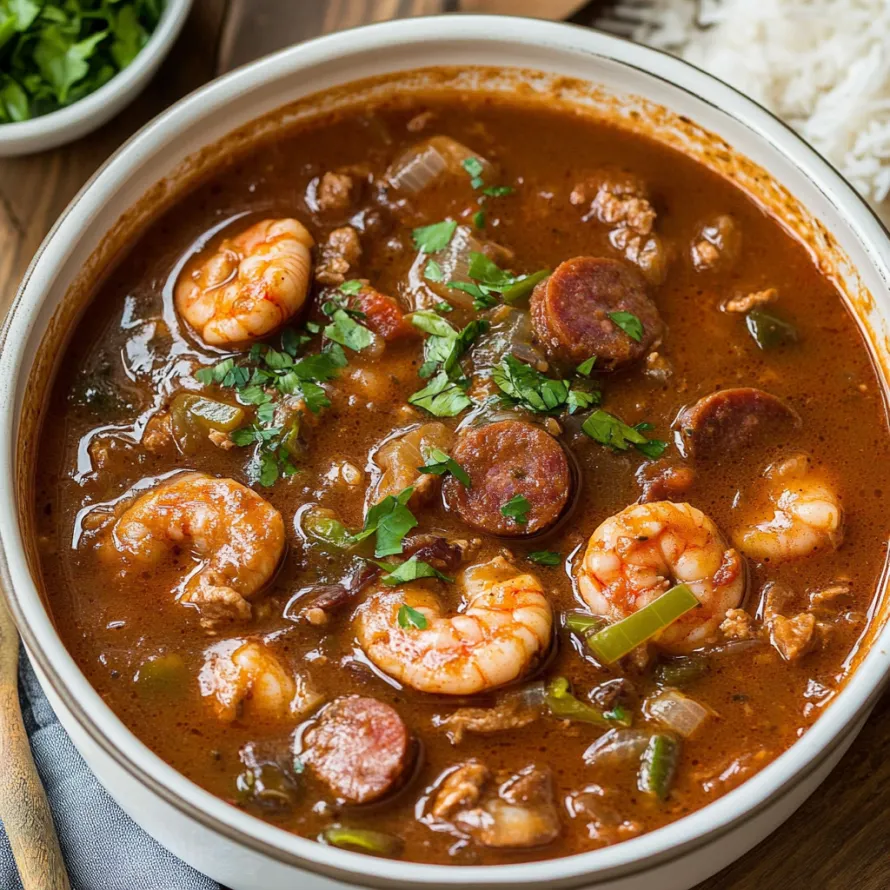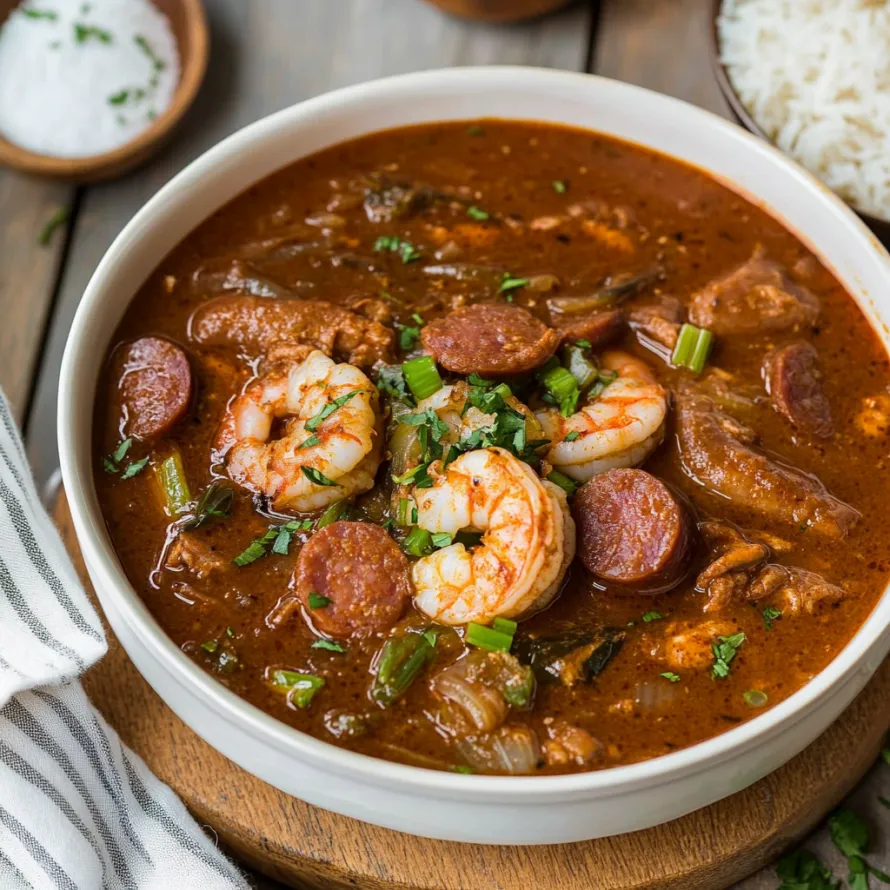 Pin it
Pin it
Take a trip to the heart of Louisiana every time you dig into a steaming bowl of gumbo loaded with shrimp, crab, and spicy sausage. This beloved bayou classic features a rich, savory broth built from a dark, deeply toasted roux that’s a labor of love. Not like jambalaya, this one’s more like a stew, bringing that slow-simmered complexity and depth that stays true to Cajun vibes.
My great aunt, who spent her days down in southern Louisiana, taught me how to make this. The first time, I totally burned the roux and almost threw in the towel. That second go, when my place started smelling just right, I finally got what she meant about waiting for the magic. Now, my family won’t let me host a dinner without it.
Tasty Ingredient Basics
- Fresh parsley and green onions: Tossed in at the very end for a bright lift.
- Seafood stock: Adds a bold, sea-kissed base that gets mellowed by a splash of chicken stock.
- Fresh Gulf shrimp: If you can, keep those shells on for awesome flavor.
- Blue crabs: These guys make the broth rich and layered really quickly.
- Andouille sausage: Delivers that perfect hit of smoky heat without drowning out the seafood.
- Yellow onions: They’re half of the flavor magic with celery and peppers.
- All-purpose flour: When mixed with oil, gives your roux that must-have color and deep flavor.
Easy Steps
- Seafood Finishing:
- Toss in your blue crabs, shrimp, and crab chunks once the soup base is ready. Move them around gently so they stay intact. Let everything go uncovered another 15 minutes. The shrimp turn pink, crab heats through, and this is when you’ll fold in chopped parsley and green onions. Tweak salt and pepper here if you want.
- Liquid Incorporation:
- Now pour in the chicken and seafood stocks slowly, whisking as you go to dodge lumps. All in? Pop in bay leaves. Keep it barely bubbling with the lid mostly on, stir sometimes, and let it mellow out for 90 minutes without rushing it.
- Protein Introduction:
- Now slide sliced andouille and smoked sausage into the veggies and get everything coated in the roux. Let it cook about 5 minutes till the sausage gives up its fat. In goes Creole seasoning, dried thyme, onion powder, and garlic powder—mix well so the flavor hits everywhere.
- Trinity Integration:
- Right when your roux is as dark as chocolate, throw in diced onions, peppers, and celery. They’ll hiss and quickly cool things down so it won’t get darker. Stir for 5 minutes so they soften and fill the kitchen with that classic aroma. Garlic in next—about a minute, just till you smell it.
- Roux Development:
- Pour oil into a heavy pot and heat until it shimmers, but don’t let it smoke. Gradually sift in flour, whisking the entire time so it stays smooth. Stir non-stop for 25–30 minutes, watching it move from pale to tan, then brown, then a deep, almost black color. Stick with it—if it burns, you’ll have to start from scratch.
 Pin it
Pin it
Spending lots of weekends in Louisiana, I quickly learned everyone claims their own gumbo wins. My grandma and her sisters would argue forever on whether file powder belonged at all. The one thing they all agreed on? Taking the time for that dark, rich roux is what sets the best gumbo apart—and I totally feel that after years of cooking it myself.
Serving Tips
Pile some classic white rice in your bowl and let the gumbo soak in. Potato salad on the side—or even scooped right into your bowl if you’re feeling bold—is how lots of locals keep things interesting. Got a piece of crunchy French bread with a soft middle? That’ll make sure no broth gets left behind.
How To Make It Yours
Mood for something extra? Stir in a handful of oysters for extra briny goodness near the end, or switch the blue crab for lobster if you’re celebrating big. Want less kick? Grab regular smoked sausage instead of andouille, but don’t skip that smoky boost—it matters.
 Pin it
Pin it
Seafood gumbo is more than its crazy depth of flavor. It’s about how Louisiana brings people together, mixing cultures and making the best of simple food. Every time I make it, I think of the generations before me who poured, stirred, and waited for something special. It takes commitment, but there’s nothing like that first bite with friends or family around.
Frequently Asked Questions
- → What's the trick to nailing seafood gumbo?
- You really want your roux to hit that dark brown color for deep, nutty flavor. Take it slow—don’t rush or you risk burning it. Seafood goes in near the end so it stays tender, not rubbery.
- → Can I make gumbo the day before?
- For sure, gumbo usually tastes even better after a night in the fridge. Cook the base, store it, then reheat and toss in your seafood just 15 minutes before eating for the best bite.
- → How do Cajun and Creole gumbo differ?
- Creole gumbo (New Orleans style) often has tomatoes and more types of seafood. Cajun versions are tomato-free but loaded with sausage and sometimes chicken. This one’s more Cajun because it skips tomatoes and uses a dark roux.
- → What should I put alongside seafood gumbo?
- Spoon it over white rice, definitely grab crusty bread for dunking, and maybe scoop up some potato salad if you want. A quick green salad is an easy side too.
- → Is it okay to use frozen seafood?
- Go for it! Thaw and pat dry before adding. Frozen shrimp and crab can still taste great, but a pinch more seasoning or a splash of fish sauce keeps the seafood flavor bold.
- → How thick is gumbo supposed to be?
- Real Louisiana gumbo sits somewhere between a soup and a stew. Not runny, not super thick—just able to coat a spoon and easy to pour onto rice. Use more or less broth until it’s just how you want.
